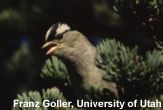Scientists Teach Sparrows to Sing Backward

You wouldn't think sparrows need to be taught how to whistle a happy tune, but Gary Rose wanted to try it anyway.
Rose and his colleagues captured about two dozen baby sparrows -- with permission, honest! -- and separated them so they wouldn't hear any sparrow songs. When the little nestlings were two weeks old, the researchers began to teach them how to perform a basic sparrow jingle using recordings made in the wild.
The music lessons were arduous, two 90-minute sessions every day for two months.
The pupils were treated like any aspiring musician, instructed in step-by-step fashion. Lessons were tailored to the students' instrument and their presumed collective goal, to sing the most common sparrow song, known as "ABCDE."
Here's how it goes: A is an opening whistle; B is bunch of notes; C is a buzz; D is a trill; and E is another bunch of notes. Importantly, the song's segments overlap, like this: AB, BC, CD and DE.
Grown-up sparrows know the number by heart. But how?
Is it genetic, like all human babies knowing exactly how to cry at 3 a.m. just after you've gone back to sleep? Or do sparrow virtuosos rely on short-term memory or, perhaps, on their long-term memories?
Sign up for the Live Science daily newsletter now
Get the world’s most fascinating discoveries delivered straight to your inbox.
Rose, a biologist at the University of Utah, aimed to find out. His team taught the sparrows their native song in snippets and never let them hear the entire recording.
One group was introduced to the correct order within the pairings: the AB measure, the BC part, and so on. The order they learned them was reversed, however. They were taught the DE part first, followed by CD and the others. The idea was to see if they could use long-term memory to pair the segments up properly, getting BC to follow AB.
Sparrows are excellent students, it turns out.
Because the song segments overlap in a fashion that makes sense to sparrows, the birds learned to put a whole ditty together on their own, in the right order, even though they learned its pieces backward.
Another group learned the segments with the inner pairings reversed, as in BA, then CB, DC and ED. Amazingly, they ended up singing the song perfectly backward, like the inverted satanic verses purported to be heard in Led Zeppelin's "Stairway to Heaven."
It would be the equivalent of you singing "lamb little a had Mary."
Some sparrows were even taught to swap A with C and other challenging arrangements.
"We always thought they needed to hear a whole song to be able to reproduce a whole song," Rose said in a telephone interview with LiveScience. "This shows they can assemble it just given the components, if you give them the linkage."
The study is detailed in the Dec. 9 issue of the journal Nature.
The results reveal that training can overcome the birds' biological tendencies -- previous research had found that sparrows have an innate disposition to start any sequence of sounds with a whistle. The study also suggests that a sparrow's song -- which can be different depending on the region a sparrow comes from -- is imprinted like a long-term memory.
Further, Rose said it appears sparrows don't memorize a whole song, but rather learn the segments and the rules for connecting them.
Your own mind may not be all that different than a bird brain.
The study may represent how brains in general learn things in sequence, as with your ability, presumably, to construct a sentence without ever having heard that exact sentence, Rose said. Another example is how someone adept at putting jigsaw puzzles together can build one without knowing what it will look like. And a jazz musician, Rose points out, "learns the rules for making transition from one note to the next, and can compose full songs by observing those rules."
The research also serves as a reminder that animals are smarter than humans once made them out to be.
"Every year we're further amazed at what animals can do, and it always exceeds what we thought they could do," Rose said.
The research team, meanwhile, will continue to study the sparrows in the lab. After being raised there, Rose said, they can't be returned to the wild. Anyway, imagine the ridicule a sparrow would have to endure, belting out EDCBA.
Robert is an independent health and science journalist and writer based in Phoenix, Arizona. He is a former editor-in-chief of Live Science with over 20 years of experience as a reporter and editor. He has worked on websites such as Space.com and Tom's Guide, and is a contributor on Medium, covering how we age and how to optimize the mind and body through time. He has a journalism degree from Humboldt State University in California.










